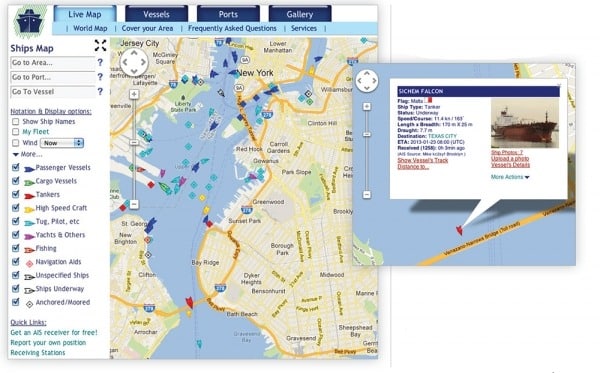
AIS stands for automatic identification system. It is a transmitter that sends your location, phone number (MMSI number) and other data over a VHF signal, where boats with a receiver can see you — along with particular information — on their MFD or a dedicated AIS receiver. It’s a commercial tool that has worked its way down into recreational boating. Every important manufacturer of marine electronics — Garmin, Furuno, Raymarine, Lowrance, Simrad, Humminbird and Si-Tex, to mention a few — offers an AIS unit in its lineup, and all of them can incorporate any AIS transceiver via NMEA link.
AIS doesn’t find fish, but it provides a lot of information that lets you find them easier, and it keeps you safer around other boats. So what use is it to a fisherman? We’ve looked at angling applications in past columns. (Go to saltwatersportsman.com/AISfishing for a discussion of how Capt. George Mitchell uses AIS to help him catch more fish in the Gulf of Mexico, and for locating bait before he heads offshore).
AIS also has an important rescue and man overboard (MOB) application. A personal transmitter broadcasts a signal to your transceiver that appears on the display or plotter screen, allowing you to circle back and pick up the unfortunate M who went OB. This functionality is destined to grow rapidly. We looked at the first iterations some months ago. (If you missed it, check out saltwatersportsman.com/AISMOB).
Safe Moves
Even though AIS doesn’t find fish, more fishermen are finding a use for AIS as a standard feature at the helm as a safety and navigational aid. Scott Heffernan, vice president of sales at the GPS Store in Ocean Isle Beach, North Carolina, routinely recommends the technology to anglers. “A lot of fishermen don’t think about AIS, but it provides another level of safety for fishing boats,” he says. “At anchor or drifting, AIS allows you to see the course of a freighter to see if there is any possibility of a collision. Otherwise you would be guessing whether they are going to hit you.” At night especially, AIS tells you what they are, where they are going and whether there is a likely conflict.
Heffernan also recommends AIS to customers when long trips are in their fishing plans. “A lot of people on the East Coast take their boats to Stuart or Key West, Florida, and with AIS, your family and friends can monitor your progress online,” he says. The monitoring he refers to is available at any number of online sites, such as marinetraffic.com, which displays information on vessels equipped with AIS transmitters. The same tracking ability is available with apps such as Shipfinder on smartphones. If you haven’t played with one of these programs, give it a try: They offer a good look at the level of information this technology provides.
Virtual Realities
One of the more forward-thinking product developers in AIS is Jeff Robbins, founder and CEO of Auckland, New Zealand-based Vesper Marine. Robbins specializes in AIS and has devoted time and energy to refining the way his receivers handle AIS information, providing a forward-looking model for the industry.
One of the problems with AIS is the way it can clutter a display screen. “Most AIS receivers just add another layer to the chart plotter,” he says. “But do you care about every ship that’s at anchor? About vessels moving away from you, or moving so slowly that an intercept is unlikely? With proper filtering and predictive plotting, you can limit the targets that appear on the AIS screen to those that are genuinely of interest for your safety.”
Another use that Robbins has pioneered is virtual targets. He describes a particular remote fjord in southern New Zealand favored by cruise ships for its beauty, but whose approach holds a particularly nasty submerged rock. Markers placed on the hazard had a short life, battered by the routine 20-footers rolling in off the Southern Ocean. Robbins installed an AIS transmitter on a promontory three miles away, and programmed it to then transmit an offset location: Now it generates a signal that creates a mark over the ship-eating rock, on the display screen of a vessel’s AIS, creating a virtual hazard marker.
The same technique was used to delineate the America’s Cup racecourse this past summer in San Francisco. The applicability in creating temporary navigational markers over shifting sandbars and channels — or more specifically, delineating particular fisheries management zones — becomes evident.
Increasingly, AIS is more than a superfluous add-on to an electronics suite; it shows every indication of assuming a role as a valuable and viable navigation utility and safety feature for anglers.
* * * * *
The U.S. Coast Guard is asking all boat owners and operators to help reduce fatalities, injuries, property damage, and associated healthcare costs related to recreational boating accidents by taking personal responsibility for their own safety and the safety of their passengers. Essential steps include: wearing a life jacket at all times and requiring passengers to do the same; never boating under the influence (BUI); successfully completing a boating safety course; and getting a Vessel Safety Check (VSC) annually from local U.S. Coast Guard Auxiliary, United States Power Squadrons(r), or your state boating agency’s Vessel Examiners. The U.S. Coast Guard reminds all boaters to “Boat Responsibly!” For more tips on boating safety, visit www.uscgboating.org.








